Bioalternatives has several canine in vitro models which were initially developed in cooperation with veterinary practitioners, especially in respect to sample sourcing for cell culture.
We have also developed models and protocols suitable for modeling pathologies (inflammation, infections, senescence, degeneration, atopic dermatitis) or aggressions (stress, wound healing).
We are presenting here some results from a study of an atopic reconstructed canine epidermis model. Please, do not hesitate to contact us for more information.
Objective of the study using atopic reconstructed canine epidermis
The objective of this study is to evaluate the efficacy of a reference molecule (REF) on a model of canine reconstructed atopic epidermis (RCE-AD). In this RCE model, atopic dermatitis is induced through a cocktail of cytokines.
1 – Evaluation of the morphology
Analysis of the morphology by histological staining highlights an inhibitory effect of the reference on the pro-inflammatory effect of the cytokine cocktail (decrease of the spongiosis, increase of the keratohyaline grains).
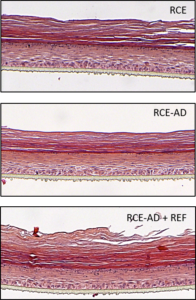
Histological morphological analysis hemalun eosin staining
2 – Evaluation of the skin barrier permeability
The analysis of the permeability of the membrane is carried out by the quantification of ceramides by LC / MS and by the evaluation of the penetration of the Lucifer yellow within the corneous layer.
The quantification of ceramides by LC / MS shows that the quantity of ceramides decreases in the presence of cytokines and that the reference does not limit the effect of cytokines.
The evaluation of the penetration of Lucifer yellow shows that the presence of cytokines (RCE-AD) increases the permeability of the tissue and promotes the penetration of Lucifer yellow. The reference inhibits the effect of cytokines on the epidermal barrier permeability.
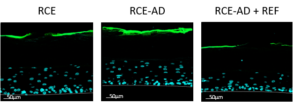
Evaluation of the penetration of Lucifer yellow into the RCE
3 – Analysis of differentiation, adhesion and tight junction proteins
The skin barrier function is also evaluated by analyzing the expression of epidermal and tight junction proteins. Differentiation proteins (Filaggrin) and adhesion proteins (Corneodesmosin) are analyzed by WES (Automated Western Blot). Tight junctions are quantified by immunolabeling.
The evaluation of epidermal proteins and tight junctions shows that the cytokine cocktail (RCE-AD) strongly decreases the expression of profilaggrine, Corneodesmosine and Claudin-1. The reference significantly decreases the effect of cytokines on the expression of these proteins.
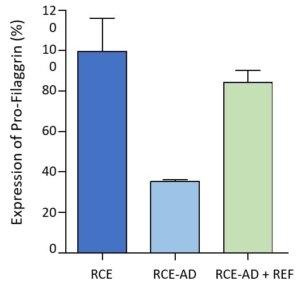
Profilaggrin expression
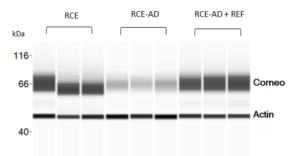
Evaluation of Corneodesmosin expression – WES
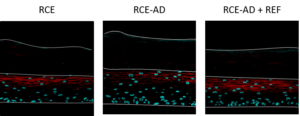
Evaluation of Claudin-1 expression by immunolabeling
4 – Evaluation of inflammation
The inflammation is evaluated by ELISA quantification of IL-8 in the medium. The assay reveals a strong increase of IL-8 secretion in the presence of cytokines and a decrease of this inflammation with the reference.
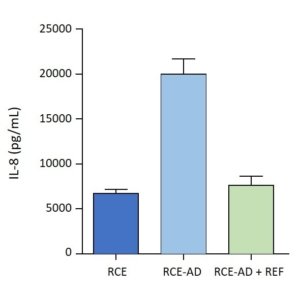
Evaluation of inflammation by ELISA quantification of IL-8










